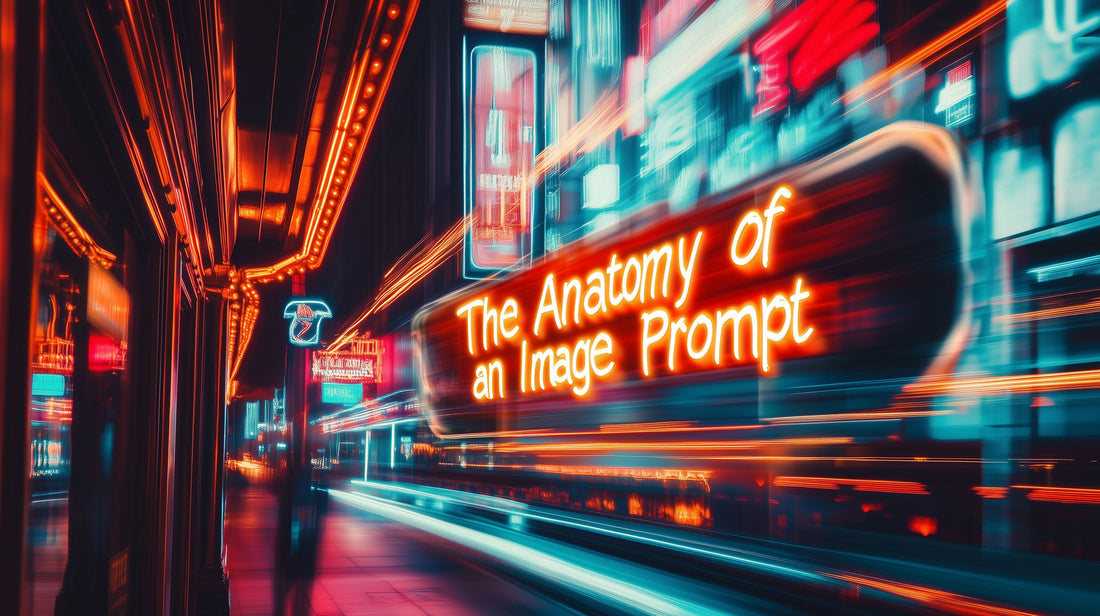
The Anatomy of an Image Prompt
Share

I recently had the opportunity to speak at an event, on a subject I’ve been completely obsessed with: creating powerful, brand-worthy visuals using AI image tools.
As a designer, I’ve always been drawn to the craft of storytelling through visuals. But with AI tools like Midjourney and others, there are new possibilities unlike anything we’ve seen before. You can create a look that feels cinematic, editorial, handmade, surreal, or completely photoreal… and you can guide the process with just words.
The trick? Writing strong, intentional image prompts.

It’s not just about typing in a vague idea and hoping for the best. It’s about treating your prompt like a blueprint—clear, descriptive, and creatively strategic. That’s what led me to put together this framework: The Anatomy of an Image Prompt. Whether you’re using AI for brand building, marketing content, or concept development, this breakdown will help you create visuals that are unique, memorable, and on-brand.
✦ 1. Subject (What)
Start with the core of your image—the main subject. Be as specific as possible. Instead of just “a woman,” try “a woman in a wide-brimmed straw hat walking through a lavender field at golden hour.” The clearer your subject, the more control you have over what shows up in the final image.
✦ 2. Style / Genre (How)
This is where you set the visual language. Are you channeling ‘70s editorial photography, vaporwave surrealism, high-fashion minimalism, or hand-painted watercolor? Style and genre help anchor the entire image in a recognizable world, and give it that intentional, art-directed feel.
✦ 3. Composition (Framing, Angle, POV)
Think like a photographer. Would you shoot this from above for a flat lay? From eye level to keep it grounded and relatable? Or from a dramatic low angle to give power and scale? Describing the perspective or layout brings cinematic dimension and storytelling to your prompt.
✦ 4. Lighting (Mood & Atmosphere)
Lighting shapes the emotion of an image. Soft natural light evokes warmth and intimacy; harsh flash adds editorial punch; neon glow can create a futuristic mood. Specify the light source, time of day, and directionality to dial in the exact vibe you’re after.
✦ 5. Color Palette
Color carries emotion and tone. Try specifying “muted earth tones,” “vibrant primaries,” “black and white,” or “pastel coastal hues.” You can also reference color combinations tied to your brand or campaign. A clear palette keeps your image feeling cohesive and purposeful.
✦ 6. Environment / Setting (Where)
The background tells as much story as the subject. Are we in a misty forest, a Parisian café, a downtown rooftop at night, or a retro kitchen? Defining the setting creates context—and can instantly transport your viewer into a fully imagined world.
✦ 7. Detailing (Texture & Materials)
Detail brings richness. Think about how things feel—glossy chrome, crinkled paper, velvety fabric, gritty concrete. Adding texture cues helps AI better render surfaces, giving your image a tactile, realistic finish that invites closer inspection.
✦ 8. Mood / Emotion (Why)
This is the soul of your image. What feeling do you want it to carry? Cozy, bold, dreamy, rebellious, nostalgic? Describing the emotional tone helps bring consistency to everything else—lighting, composition, color—and connects with your audience on a human level.
✦ 9. Additional Elements or Accessories
Add storytelling layers by including props, wardrobe, or unexpected visual details. Think: oversized sunglasses, vintage suitcases, a dog wearing a bandana, cherry blossoms falling in the background. These extras make your image more unique and memorable.
✦ 10. Modifiers & Technical Specs
Finally, use modifiers to fine-tune your output. Want it “shot in 8K,” “portrait orientation,” “cinematic ratio,” or “with film grain”? These cues let you guide the image detail, format, or even era. They’re especially useful if you're creating assets for specific channels or campaigns.
Want the Full Presentation?
If you're curious to go deeper or want a copy of my presentation from the talk, I’d love to share it with you! It’s full of visuals, examples, and expanded tips for each section above.
Just sign up for our newsletter below and you’ll get instant access to the full download. You’ll also get fresh Coffee Talk updates, creative tools, and AI experiments I’m learning along the way.
Let’s keep creating—smarter, faster, and more beautifully than ever.
Let’s Get Growing, Together. ☕️🌱









